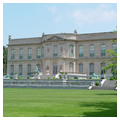You are here
Edward Julius Berwind House (The Elms)
Built for Philadelphia-born coal magnate Edward Berwind and his wife, Herminie Strawbridge Torrie, as their summer home, The Elms, like so many of Horace Trumbauer's residential designs, was carefully modeled on eighteenth-century French antecedents. The entire west-facing garden facade of the Berwind House is an enlarged copy of the garden elevation from the Château D'Argenson at Asnières, which the Berwinds visited only a year before their Newport mansion was designed. The four terra-cotta statues installed against that wall were probably purchased from the French château during that trip.
In some respects, this building addresses its private garden more than it does Bellevue Avenue. The restrained classicism of Trumbauer's street facade is reflected in its smooth limestone facing and in the monumental columns and piers flanking the main entryway. A third story is hidden from view, tucked behind the uppermost edge of a blind stone balustrade which caps the entire cornice. This rather rigid arrangement is somewhat loosened on the garden facade. Trumbauer maintains the balance and regularity of the front, but a central bay swells from the main block of the house in a graceful volume echoing the curved top windows, moldings, and decorative grillwork found throughout.
All interior details have survived from the Berwinds' era. Upon entering, one passes beneath an enormous arcaded wall atop Ionic columns of highly variegated marble, creating a sumptuous effect. The sense of an eighteenth-century pastiche is elaborated in the furniture, hardware, and draperies, all orchestrated by the Parisian firm Allard et fils. Much of the art was purchased through the international art dealer Joseph (later Baron) Duveen in London. The eclecticism at the turn of the century is reflected in the range of historical periods, from sixteenth-century Venice to eighteenth-century France and nineteenth-century Vienna, represented in interior details.
Along the western side of the eleven-acre property are the largely intact gardens. Among the most developed of Newport's formal landscaping schemes, these are replete with sunken gardens, fountain statuary, and geometrically planted parterres. The combination stable-garage, in a style similar to that of the main house, dates from about a decade later, when horse-drawn carriages were just beginning to be replaced by automobiles.
Writing Credits
If SAH Archipedia has been useful to you, please consider supporting it.
SAH Archipedia tells the story of the United States through its buildings, landscapes, and cities. This freely available resource empowers the public with authoritative knowledge that deepens their understanding and appreciation of the built environment. But the Society of Architectural Historians, which created SAH Archipedia with University of Virginia Press, needs your support to maintain the high-caliber research, writing, photography, cartography, editing, design, and programming that make SAH Archipedia a trusted online resource available to all who value the history of place, heritage tourism, and learning.

























